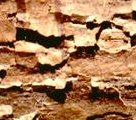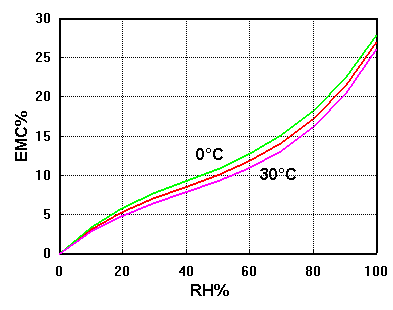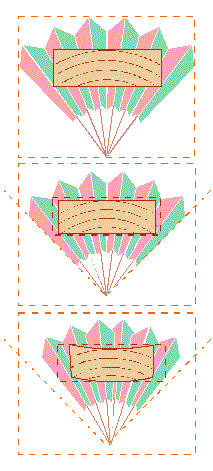
 |
The reaction of wood to changing climate |
Wood expands and contracts as it exchanges water vapour with the surrounding air. The dimensional change depends on the relative humidity change and also on the direction, referred to the orientation of the piece of wood when it was still within the tree.
 The first diagram shows the water content of wood in equilibrium with a given RH. Notice that the equilibrium is hardly affected by temperature but tends towards a lower water content at higher temperature.
The first diagram shows the water content of wood in equilibrium with a given RH. Notice that the equilibrium is hardly affected by temperature but tends towards a lower water content at higher temperature.
 In this diagram the water content-RH curves are simplified to a single curve and set beside the graph showing the shrinkage of wood from the saturated (green) state. The shrinkage lines are nearly straight, indicating that the dimensions of a piece of wood change in proportion to the water content, rather than the RH. There are two lines, because the shrinkage in the direction around the trunk of the tree (tangential) is nearly twice as great as the shrinkage in the direction from the centre to the outside of the trunk (radial). The shrinkage in the longitudinal direction (axial) is very small and is not shown on the diagram.
In this diagram the water content-RH curves are simplified to a single curve and set beside the graph showing the shrinkage of wood from the saturated (green) state. The shrinkage lines are nearly straight, indicating that the dimensions of a piece of wood change in proportion to the water content, rather than the RH. There are two lines, because the shrinkage in the direction around the trunk of the tree (tangential) is nearly twice as great as the shrinkage in the direction from the centre to the outside of the trunk (radial). The shrinkage in the longitudinal direction (axial) is very small and is not shown on the diagram.
 Planks that need to be dimensionally stable are cut to include the two directions of minimum movement, axial and radial. This is quite a wasteful and time consuming way of cutting up a tree, so it is not always done.
Planks that need to be dimensionally stable are cut to include the two directions of minimum movement, axial and radial. This is quite a wasteful and time consuming way of cutting up a tree, so it is not always done.
The deformation resulting from loss of water from a plank sawn in a tangential direction is illustrated in the fan diagram, where the pivot of the fan represents the centre of the tree. A horizontally cut section is painted onto the fan. The shrinking caused by loss of water can be artificially divided into two stages: a uniform shrinkage, shown by the second fan, followed by partial closing of the fan (third image), to imitate the extra tangential shrinkage. The section of plank painted on the fan changes size during the first step but changes shape during the second part of the process.
The shrinkage in the line of the trunk (axial) is so small that it is customarily ignored. The problem with ignoring small effects is that one risks neglecting the consequences of their smallness. The stability of wood along the grain, in the direction of the trunk of the tree, can cause delamination of surface coatings that suffer greater movement with moisture change, as shown in the next part

This work is licensed under a Creative Commons Attribution-Noncommercial-No Derivative Works 3.0 License.